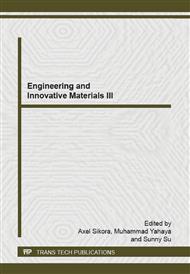p.36
p.40
p.45
p.50
p.57
p.65
p.71
p.76
p.81
Diode Parameters of Heterojunctions Comprising p-Type Si Substrate and n-Type β-FeSi2 Thin Films
Abstract:
n-Type β-FeSi2/p-type Si heterojunctions have been successfully fabricated by facing-targets direct-current sputtering at a substrate temperature of 600 °C without post-annealing and their current-voltage characteristics were measured at low temperatures ragne from 300 K down to 50 K. The ideality factor, saturation current and series resistance were estimated by the thermionic emission theory and Cheung’s method. By the thermionic emission theory, we calculated the ideality factor from the slope of the linear part from the forward lnJ-V and estimated the saturation current density from the straight line intercept of lnJ-V at a zero voltage. As decreasing temperatures from 300 down to 50 K, the value of ideality factor increased from 1.2 to 15.6, while the value of saturation current density decreased from 1.6 × 10−6 A/cm2 to 3.8 × 10−10 A/cm2. From the plots of dV/d (lnJ)-J and H(J)-J by Cheung’s method, the obtained values of series resistances are consistent with each other. The series resistances analyzed from both plots increased as decreasing temperatures.
Info:
Periodical:
Pages:
57-61
Citation:
Online since:
October 2014
Price:
Сopyright:
© 2014 Trans Tech Publications Ltd. All Rights Reserved
Share:
Citation:


